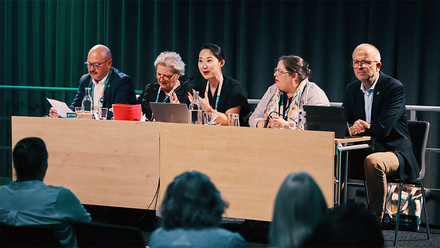International education’s need for a ‘big idea’

International education as we know it today owes its existence to a ‘big idea’ – a post-World War Two desire to connect and integrate individuals and nation-states to prevent future conflict. As the sector faces increasing calls to address ‘big ideas’ that will transform communities (eg climate change, geopolitical tensions), it is imperative to consider the conditions necessary to realise such outcomes.
While strategic internationalisation can transform communities, too frequently institutions fail to foster the necessary conditions to achieve such results. If institutions are serious about leveraging international education to transform communities, they must create an environment that promotes the following dynamics.
Planning and strategy
Addressing a ‘big idea’ requires planning and a clear strategy. This is foundational to effective community engagement – even more so when engaging cross-culturally. ‘Big ideas’ necessitate long-term initiatives that engage a variety of stakeholders across multiple communities. Beginning such initiatives without careful attention to planning and strategy is a recipe for failure. Even with a clear plan and strategy, the longitudinal nature of addressing ‘big ideas’ requires continual refinement – a process too few institutions adopt when internationalising or engaging external communities.
Relationship building
When an institution wants to engage communities, it needs a strategy for who to engage and how. Community engagement is about building relationships. Individuals within the institution and in the community need time and space to get to know each other, to build trust and to develop a shared commitment to the ‘big idea.’
Even with a clear plan and strategy, the longitudinal nature of addressing ‘big ideas’ requires continual refinement
In international education, this often requires learning and sharing culture. While most would agree this is a condition for successful community engagement, the real question for institutions is time. Can and do institutions devote time to, allow for and promote relationship building? That is, do they provide the time and space for faculty, staff, students and administrators to develop deep relationships with community stakeholders? Once institutional stakeholders build relationships, leaders must be open to revising plans and strategy, as community stakeholders may highlight some elements of the plan or strategy that are not be feasible or lack support. Thus, planning and strategy have a direct connection to relationship building.
Including diverse voices
Making time and space to build relationships is crucial for any organisation. However, community engagement in international education requires involving stakeholders from a variety of backgrounds. Diversity, equity, access, justice and inclusion are not simply buzzwords; they are foundational practices for successful internationalisation. Integrating such practices into attempts to address ‘big questions’ must be a priority. If an institution desires to engage its community partners in addressing ‘big questions,’ it must first ensure it is equipped to bring all voices to the table and to create an open and trusting environment at that table where all individuals, groups and communities are free to share ideas.
Diversity, equity, access, justice and inclusion are not simply buzzwords; they are foundational practices for successful internationalisation
Given the inequities built into the global system, this is a serious challenge influencing both planning and strategy as well as relationship building, and is especially important when the communities with which institutions engage are marginalised and/or exploited. It is far too easy for predominately White, Western institutions to adopt a ‘white saviour’ approach that ultimately further entrenches individuals and communities in the very systems that addressing ‘big ideas’ seeks to dismantle. Only through planning, strategy, and relationship building can educational institutions embrace the full diversity of their communities.
Committing to multi-generational approaches
The nature of ‘big ideas’ is that they require cooperation and engagement from stakeholders across communities. Communities rarely consist of a singular demographic, which means that the resources, needs and challenges of those communities are varied. What is most beneficial to an octogenarian may be irrelevant to a teen living in the same community. A singular approach is rarely sufficient to address a ‘big question.’
What is most beneficial to an octogenarian may be irrelevant to a teen living in the same community
Further, as most ‘big ideas’ require long-term initiatives, institutions need multi-generational teams committed to the project. Income inequality and the climate crisis are global challenges that will not be fully addressed in my lifetime or yours. International education offers meaningful solutions to these challenges, but the magnitude of these challenges (and corresponding solutions) is such that the leaders and change agents of today must be recruiting and training the leaders and change agents of tomorrow to continue the work. While this complicates planning and strategy, relationship building and honouring diverse voices, it is critical to successfully addressing ‘big ideas.’
Integrating ‘big ideas’ into curricula
Curriculum is the foundation of an educational institution, which reflects the mission, values and goals of the institution. Implementing lasting change in international education typically requires some connection to curriculum; therefore, institutions that want to address ‘big ideas’ through community-engaged internationalisation need to embed such work throughout their curricula. Processes to adapt curricula are typically slow and deliberative, and require planning and strategy, as altering a singular component may produce a cascade effect across the entire curriculum.
Further, enacting such change requires support from faculty, administrators and in many cases oversight boards, accrediting agencies and/or government ministries. Facilitating agreement for curricular revision may also require backing from business and industry leaders to obtain support from some of the stakeholders involved and/or impacted by such a change. Thus, planning, strategy, and relationship building with diverse stakeholders is essential for community-engaged curricular internationalisation.
Acknowledging and rewarding labour
Stakeholders judge an institution’s values and goals through what it rewards, and far too frequently, internationalisation and community engagement are not rewarded. If institutions desire international education to engage communities in ‘big idea’ initiatives, they must reward and compensate such activities.
Stakeholders judge an institution’s values and goals through what it rewards, and far too frequently, internationalisation and community engagement are not rewarded
For faculty, this means examining tenure and promotion guidelines as well as teaching, research and service obligations. For students, it means considering grading schemes and degree programming. For staff, it means evaluating annual review and promotion criteria. For communities, it means exploring outcomes and impacts. Regardless of the stakeholders, this involves time, money and other resources – at least some of which must be directed to communities beyond the institution. If institutional leaders claim to value community-engaged internationalisation, the reward and compensation structures for such work must follow. Otherwise, there will be minimal stakeholder support for planning, strategy, relationship building or curricular revision as they are simply time- and labour-intensive burdens.
Rethinking assessment mechanisms
Assessment is a major driver of modern educational institutions, and it is clear that any efforts international education undertakes to address ‘big ideas’ will be assessed. Herein lies the challenge for community-engaged internationalisation: most widely-adopted assessment metrics are quantitative and short-term, yet this discussion highlights that the conditions necessary for successful community-engaged internationalisation to address ‘big ideas’ are longitudinal and multi-faceted in ways that may require qualitative assessment.
How does an institution assess the quality of relationship building? How does it assess long-term planning and revision? How do university rankings account for such activities? One of the reasons that institutions fail to prioritise ‘big idea’ work is that the metrics used to evaluate them do not value internationalisation to transform communities, and all of the relevant stakeholders know it. For stakeholders to engage in the previous strategies, assessment metrics must capture their activities.
Encouraging international education to tackle ‘big ideas’ is critical to societal transformation and requires attention these interconnected strategies, yet most institutions lack the environment to support such initiatives. While these seven strategies do not guarantee success, they provide a framework for engaging communities to build a better future.






